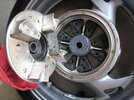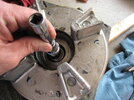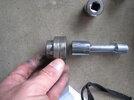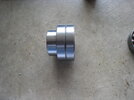Please: This is my first try at this, those with more experience please
chime in with your tips and tricks that might help make this a better
procedure.
Rear Flange Bearing RR
Step 1
Remove Ring - This is pretty simple, some needle nose pliers will
work, the ring does not have a lot of tension on it.


Step 2
Remove Flange - I had to tap my flange some to help loosen it up.






Then, by jiggling it a little it will come right off.





Step 3
Drive out Bearings - Using a socket, drive out the distance
collar from the other side of the flange.






You don't have to use much force.



Now, using a smaller socket, drive out the distance collar from
the bearings.






Step 4
Install new Bearings - Some people put the new bearings in the
freezer for a few hrs, I did for a couple and it helped but I should
have left them in longer.
The new bearings will tap into the distance collar pretty easy.






Then line it up on the flange.



To drive the near bearings into the flange, you can try using a
large socket but make sure the socket only touches the outer
race/part of the bearing - force on the bearings or inner race
could render them inoperable.



I had a couple socket that looked like they might work however,
they had a beveled edge and I was afraid that would harm the
outer race or do other damage.
So, I used the old bearings and tapped the outer edge a little at a
time to push the new bearings into the flange. Worked better than I
thought it would.



Some have used a board to drive in the bearings also.
That's it! It's a lot easier than I thought.
chime in with your tips and tricks that might help make this a better
procedure.
Rear Flange Bearing RR
Step 1
Remove Ring - This is pretty simple, some needle nose pliers will
work, the ring does not have a lot of tension on it.

Step 2
Remove Flange - I had to tap my flange some to help loosen it up.


Then, by jiggling it a little it will come right off.


Step 3
Drive out Bearings - Using a socket, drive out the distance
collar from the other side of the flange.


You don't have to use much force.

Now, using a smaller socket, drive out the distance collar from
the bearings.


Step 4
Install new Bearings - Some people put the new bearings in the
freezer for a few hrs, I did for a couple and it helped but I should
have left them in longer.
The new bearings will tap into the distance collar pretty easy.


Then line it up on the flange.

To drive the near bearings into the flange, you can try using a
large socket but make sure the socket only touches the outer
race/part of the bearing - force on the bearings or inner race
could render them inoperable.

I had a couple socket that looked like they might work however,
they had a beveled edge and I was afraid that would harm the
outer race or do other damage.
So, I used the old bearings and tapped the outer edge a little at a
time to push the new bearings into the flange. Worked better than I
thought it would.

Some have used a board to drive in the bearings also.
That's it! It's a lot easier than I thought.
Last edited:


